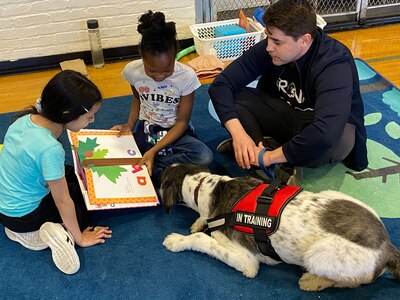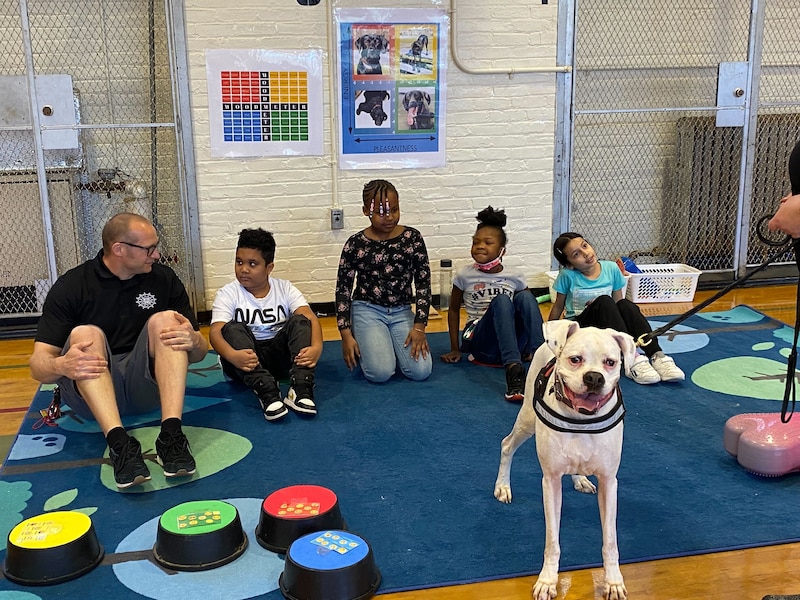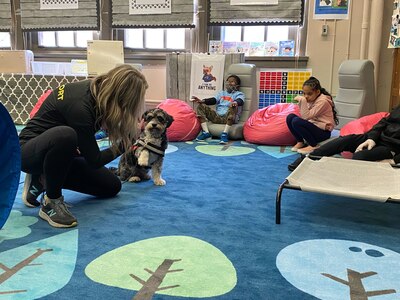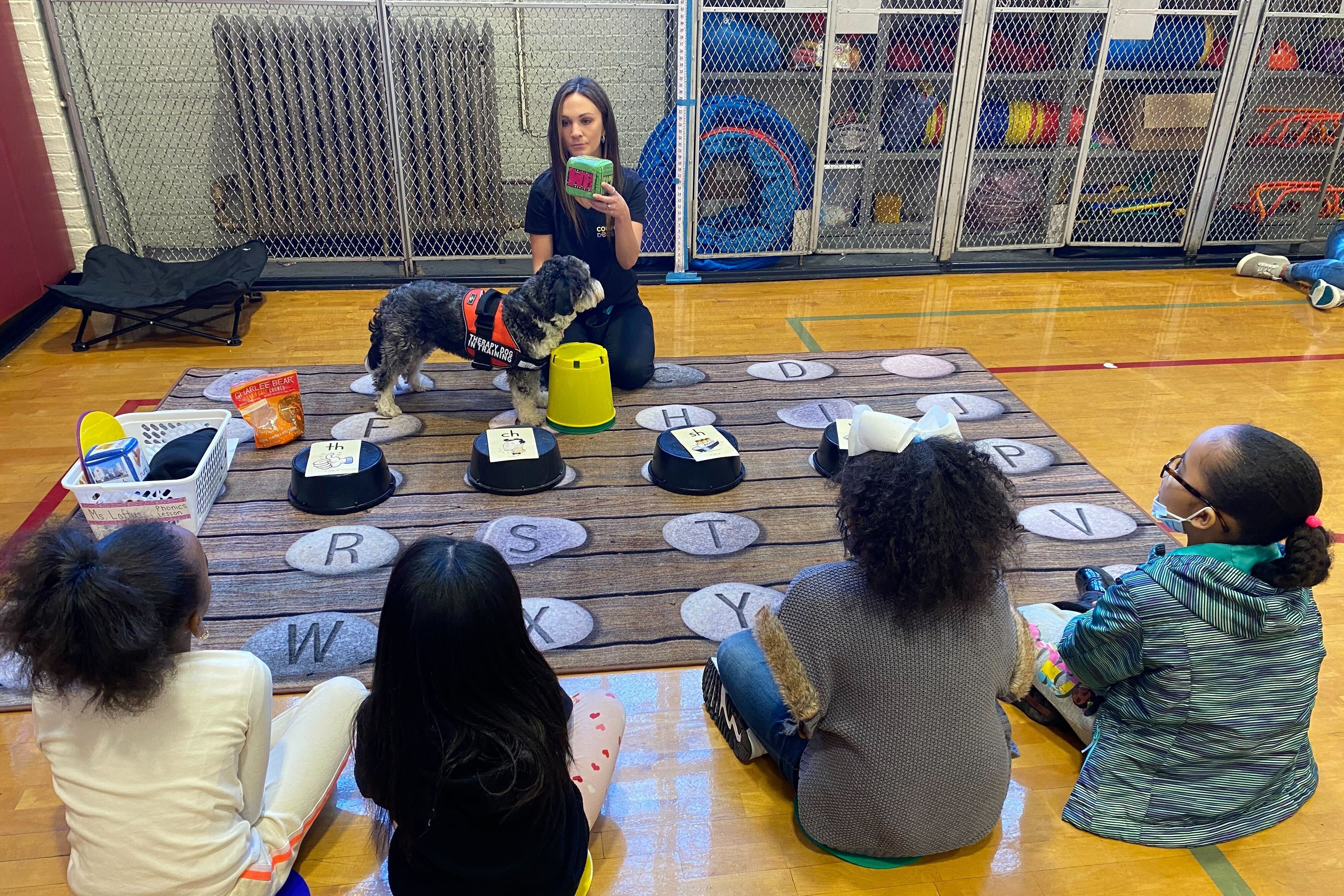Literacy coach Meredith Loftus sometimes has a special helper for her phonics lessons with struggling readers at P.S. 70 in the South Bronx.
Chip, a 1.5-year-old shih-poo (poodle/Shih Tzu mix), joined her on Thursday, as she worked with a small group of third graders as they sounded out words with digraphs, two letters that sound like one, such as “wh,” “sh,” “ch,” and “th.”
Chip used his nose to toss a large die with a word on each side, and it landed on “shoulder.” Then a student read the word and instructed Chip to pick a bucket with the corresponding digraph.
Getting students excited about being pulled out of their regular classroom to work on phonics can be a struggle — particularly this year, when pandemic-related learning disruptions have left some kids lagging several years behind. But having the dogs helps make it more fun, said Kirsten Kinsella, P.S. 70’s former assistant principal, who now leads the New York City education department’s Comfort Dog Program.
“They explain the sounds to Chip. They’re learning it with the dog,” Kinsella explained. “It builds confidence and communication.”
Chip is one of five dogs who regularly works with P.S. 70 students on literacy, math, yoga, and social-emotional skills. When he’s not at the school, he and the other four dogs live with Kinsella, who has continued to use the school as her home base and lab site. She Zooms with educators at the city’s other 52 schools with dogs in the program to see how things are going and to troubleshoot. P.S. 70 is also where she certifies dogs before they head to their respective schools.

Kinsella gets inquiries from educators “every day” about the program and said over 500 schools want to participate.
This kind of targeted literacy intervention puts the Comfort Dog Program at the forefront of how schools can incorporate the therapeutic animals, Kinsella believes. Such activities are also more engaging for the dogs than simply being petted all day. (“I’m like the UFT for the dogs,” Kinsella joked, comparing her role to the teachers union’s in ensuring the pups have good work conditions.)
Though dogs have been in some New York City public schools since 2016 as a way to bolster emotional well-being, their roles in the classroom have been evolving, and training them — along with training their humans — is an ongoing process. Interest in the program has been especially high this school year, as student mental health needs have become dire across the nation; in October 2021, theAmerican Academy of Pediatrics declared a national emergency about the issue.
Hundreds of schools want dogs
The program expands and contracts based on various factors, and Kinsella expects to certify six new dogs before the school year ends. While she’s hopeful the program will grow, it’s a major undertaking to train the dogs and their humans. An education department pilot program this year is sending a school professional, who is also a dog trainer and animal-assisted intervention specialist, into various schools with her dog to work with teachers for part of the day.
To be part of the program, an educator with a dog at least a year old must participate in a six-hour training program through the Good Dog Foundation.. Schools can allocate up to $1,000 from their budgets to help defray costs, Kinsella said, but the educator is a volunteer, providing room and board for the pet.
The training focuses on how to work with students who might be scared of dogs or how to desensitize dogs to school-specific distractions like the school bell, fire alarms and PA announcements.
But going through the training does not automatically guarantee acceptance into the program, as other factors might come into play in terms of how the dog responds to being in a school environment. The dogs must also exhibit a love for greeting strangers without hesitation and cannot exhibit any aggression. And their handlers have to become skilled at reading their dogs’ stress signals, Kinsella said.

A little help from a friend on social-emotional learning
The comfort dogs have been especially helpful this year as children had to reacclimate to being back in the classroom around other children and adults, Kinsella said. For some students who have been reluctant to show up to school, they now start their day feeding the dogs, a calming transition before school work.
“Through the dogs and working with them and seeing that bond, we just see the students grow,” she said.
She pointed to the transformation of Ian, a third grader who was having trouble remaining in class this year. Now he helps train the dogs.
“They make me feel more excited to be here,” Ian said. “They’re my best friends.”
He’s already planning to be a dog trainer when he grows up, he said.
Kinsella worked with Ian and three other students on some social-emotional skills in a quiet fifth-floor classroom — where the dogs usually stay, so that children who are allergic to dogs don’t encounter them elsewhere.
She started out by asking the children how they felt, and said that Chip felt “ner-cited,” which was a made-up word for nervous and excited, Kinsella told the children.

A third grader named Izzy said he also felt nervous because there were more people than usual watching the group. But he said he also felt grateful because “a lot of people don’t get chances” to spend time with dogs in school.
Izzy then led the group in a short, guided meditation with deep-breathing exercises.
When he finished, the four students and two dogs in the room all seemed more at ease.
“When we change the energy in the room, we change the energy for the dogs and ourselves,” Kinsella said.
Amy Zimmer is the bureau chief for Chalkbeat New York. Contact Amy at azimmer@chalkbeat.org.







